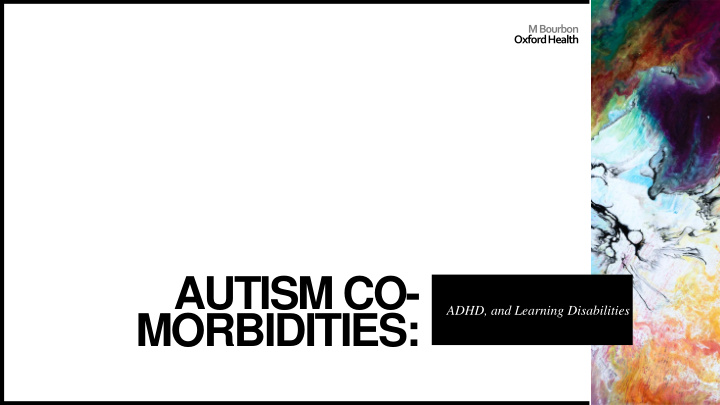



M B0urbon Oxford Health AUTISM CO- ADHD, and Learning Disabilities MORBIDITIES:
Current data (cont) Specific learning difficulties: Dyslexia in 14% of those who have no LD and no language delay Dyscalculia Dyspraxia Maria Bourbon 2 Oxford Health
Current data ADHD : co-occurrence in 59% of children diagnosed with ASD Learning disabilities : approximately 30- 40% of people with ASD have IQ<70; further 20-25% with borderline LD (IQ of 71-85); High level of specific LD (e.g. dyslexia) , but difficult to quantify Maria Bourbon 3 Oxford Health
ADHD Criteria: • Must have symptoms of inattention, impulsiveness and hyperactivity (different combinations for different types) • Child must be five years or older to get an ADHD diagnosis, and symptoms must be present before 12 years of age • Symptoms must be present for over 6 months • Learning difficulties may lead to inattention / disruptive behavior which is not related to ADHD, even if the symptoms are similar • ASD and ADHD share some common characteristics like not seeming to listen when people speak, interrupting, or intruding on other people’s personal space. Many children with ASD have behaviour that’s very similar to ADHD NOTE: Average age at diagnosis was over 6 years for children with ASD + ADHD but close to 2.5 years for children with ASD only (Stevens, Peng, & Barnard-Brak, 2016) Maria Bourbon 4 Oxford Health
Learning disabilities Criteria: • it was thought that 50-60% of children with ASD had a learning disability or developmental delays. • Intellectual disability can be diagnosed when a child who is six years or older has an IQ below 70 as well as difficulties with daily tasks. In children under six years, the term developmental delay is used when children have significant cognitive and language delays. • some children’s developmental delays might be caused by their communication and social learning difficulties, rather than LD NOTE: Average age at diagnosis was over 6 years for children with ASD + ADHD but close to 2.5 years for children with ASD only (Stevens, Peng, & Barnard-Brak, 2016) Maria Bourbon 5 Oxford Health
COGNITIVE PROFILE OF SOMEONE WITH ASD Oliveras-Rentas, Kenworthy, Roberson, Martin, & Wallace, 2012 • Weaknesses in processing speed - more than half (55%) of the sample scored at least a full standard deviation. It is unclear whether this reflects actual cognitive processing speed or motor speed difficulties (or both). • Also weaknesses in Comprehension (complex social language demands). Relies on a general understanding of social behavior. • Strengths in structured, brief, motor-free task (similarities/matrix reasoning), i.e. in taskswhere they are asked to provide short verbal responses or complete untimed, motor- free nonverbal tasks. Maria Bourbon 6 Oxford Health
THE BIG PICTURE Maria Bourbon 7 Oxford Health
THE BIG PICTURE Maria Bourbon 8 Oxford Health
References Oliveras-Rentas, R. E., Kenworthy, L., Roberson, R. B., Martin, A., & Wallace, G. L. (2012). WISC- IV profile in high-functioning autism spectrum disorders: impaired processing speed is associated with increased autism communication symptoms and decreased adaptive communication abilities. Journal of Autism and Developmental Disorders, 42(5), 655-664. Stevens, T., Peng, L., & Barnard-Brak, L. (2016). The comorbidity of ADHD in children diagnosed with autism spectrum disorder. Research in Autism Spectrum Disorders, 31, 11-18. Russell, G., and Pavelka, Z. (2013). Co-Occurrence of Developmental Disorders: Children who Shre Symptoms of Autism, Dyslexia and Attention Deficit Hyperactivity Disorder. Recent Advances in Autism Spectrum Disorders – Volume I, 361-386. White, S. W., Oswald, D., Ollendick, T., & Scahill, L. (2009). Anxiety in children and adolescents with autism spectrum disorders. Clinical Psychology Review, 29(3), 216- 229. Maria Bourbon 9 Oxford Health .
Maria Bourbon Oxford Health THANK YOU 10
Recommend
More recommend